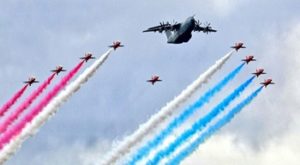
The chocks came off for Farnborough 2016 with several big numbers and trade deals. An estimated £94 billion worth of orders and options were recorded over the five day event, with 856 aircraft at £71 billion, 1407 engines at £17 billion and a variety of other business deals being traded. The show was a success and these figures are tantamount to the strength of the industry at a time of uncertainty.
With doing business comes research and innovation – from better wing designs, more powerful engines to lighter materials to make planes out of. This ‘academia-industry’ bridge is critical to the future growth of the sector in the UK. What Farnborough demonstrated to me is how interconnected and complex innovation can be for all involved. Remember a slight change in the design of an aircraft can have implications for the supply chain, which is now more international than ever. Just look at the Airbus 380 with parts produced across several countries.
With the UK being home to world-class academic institutes in aerospace research the UK government and industry committed almost £365 million of funding for new aerospace research and development. This builds on the £1.2 billion of funding going into the Aerospace Technology Institute, where over 149 research targets, involving 188 different companies and organisations, target different aspects of aircraft manufacturing and performance. All excellent platforms for UK companies, including SMEs, to work together to innovate and grow.
So why does this matter to my work? India is ambitious and aiming to become the third largest aviation market by 2020 and largest by 2030. Its economy is growing and talent pipeline into areas such as software development make it a major player. Air travel is predicted to grow by 12-15% annually here meaning building new airports, some say from 40 to 90 in the next decade, to cater for bigger demand. All this will require more planes and more broadly infrastructure not just to handle passengers but also air cargo. What India is looking for are technology partners in areas where the UK excels – from plane design, engine technology and advanced materials. So there’s great scope for UK and Indian partners to develop new cutting edge technologies for the future.
I recall Airbus’s A320 was the first digital fly-by-wire airliner, which revolutionised the role of the pilot and the safe operation of civilian aircraft. There are other ways that we may be returning to the joy of flying that Abram C Pheil might have seen from the passenger seat of a flying boat 100 years ago – such as the bigger windows of the 787 Dreamliner. So the next couple of decades will herald changes in flying once again with developments in additive manufacturing and automation. I think the UK and India will have a role in shaping that future.
PS: The Farnborough International Airshow is a great event showcasing the UK’s excellence in this sector. We have another opportunity later this year at the India-UK Technology Summit, which will take place from 7-9 November, in Delhi. More details will follow shortly.
